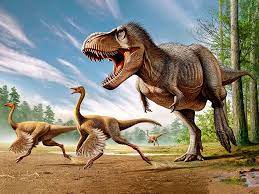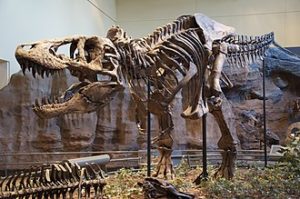SCI-PALEONTOLOGY | Dinosaur footprints were discovered in China

The Mill Canyon Dinosaur Tracksite contains roughly 200 footprints from at least 10 different dinosaurs.BLM
- Two dinosaur footprints were discovered by a customer at a restaurant in Sichuan province, China.
- The footprints belonged to sauropods from the Cretaceous period.
- It’s rare to find remnants from China’s Cretaceous period, a paleontologist said.
Dinosaur footprints from more than 100 million years ago were accidentally discovered by customer eating at a restaurant in China
.



Dinosaurs footprints from over 100 million years ago were accidentally discovered by a customer eating in the courtyard of a restaurant in China, The Washington Post reported.
The footprints belonged to two dinosaurs that roamed the Sichuan province, paleontologists discovered.
Lida Xing, a paleontologist and associate professor at the China University of Geosciences, told CNN the footprints belonged to sauropods, who are known for their long necks and tails. Sauopods were the largest animals on Earth.
Ads by:
 Memento Maxima Digital Marketing
Memento Maxima Digital Marketing
@[email protected]
SPACE RESERVE FOR ADVERTISEMENT
.
“Sauropod tracks are not rare in Sichuan Basin … but they are very rare[ly] found in restaurants in downtown,” Xing told the Post in an email. “Most of the time, the ground of the city is either vegetation or cement.”
These sauropods roamed Earth during the Cretaceous period, Xing told CNN. She said that while finding dinosaur prints in the province isn’t uncommon, it’s rare to discover prints from the Cretaceous era when “dinosaurs really flourished.”
Xing said she estimated that the two footprints likely belonged to sauropods measuring 26 feet long, CNN reported.
According to CNN, the restaurant where the footprints were found only opened in the past year. Before that, the area was a chicken farm, and layers of dirt helped protect the footprints from erosion.
Xing told CNN that the restaurant owner put up a fence around the footprints to stop people from stepping on them. He might also build a shed to further preserve them.
Ads by:
 Memento Maxima Digital Marketing
Memento Maxima Digital Marketing
@[email protected]
SPACE RESERVE FOR ADVERTISEMENT
“This discovery is actually like a jigsaw, adding a piece of evidence to Sichuan’s Cretaceous period and the diversity of dinosaurs,” Xing said.
Read the original article on Insider
INSIDER
.
TRIVIA:
What is Paleontology? Paleontology is the study of ancient life, from dinosaurs to prehistoric plants, mammals, fish, insects, fungi, and even microbes. Fossil evidence reveals how organisms changed over time and what our planet was like long ago.
.
Paleontology

.
Paleontology (/ˌpeɪliɒnˈtɒlədʒi, ˌpæli-, –ən-/), also spelled palaeontology[a] or palæontology, is the scientific study of life that existed prior to, and sometimes including, the start of the Holoceneepoch (roughly 11,700 years before present). It includes the study of fossils to classify organisms and study their interactions with each other and their environments (their paleoecology). Paleontological observations have been documented as far back as the 5th century BCE. The science became established in the 18th century as a result of Georges Cuvier‘s work on comparative anatomy, and developed rapidly in the 19th century. The term itself originates from Greekπαλαιός (‘palaios’, “old, ancient”), ὄν (‘on’, (gen.‘ontos’), “being, creature”), and λόγος (‘logos’, “speech, thought, study”).[1]
Paleontology lies on the border between biology and geology, but differs from archaeology in that it excludes the study of anatomically modern humans. It now uses techniques drawn from a wide range of sciences, including biochemistry, mathematics, and engineering. Use of all these techniques has enabled paleontologists to discover much of the evolutionary history of life, almost all the way back to when Earth became capable of supporting life, nearly 4 billion years ago.[2] As knowledge has increased, paleontology has developed specialised sub-divisions, some of which focus on different types of fossil organisms while others study ecology and environmental history, such as ancient climates.
Body fossils and trace fossils are the principal types of evidence about ancient life, and geochemical evidence has helped to decipher the evolution of life before there were organisms large enough to leave body fossils. Estimating the dates of these remains is essential but difficult: sometimes adjacent rock layers allow radiometric dating, which provides absolute dates that are accurate to within 0.5%, but more often paleontologists have to rely on relative dating by solving the “jigsaw puzzles” of biostratigraphy (arrangement of rock layers from youngest to oldest). Classifying ancient organisms is also difficult, as many do not fit well into the Linnaean taxonomy classifying living organisms, and paleontologists more often use cladistics to draw up evolutionary “family trees”. The final quarter of the 20th century saw the development of molecular phylogenetics, which investigates how closely organisms are related by measuring the similarity of the DNA in their genomes. Molecular phylogenetics has also been used to estimate the dates when species diverged, but there is controversy about the reliability of the molecular clock on which such estimates depend.
.
Ads by:
 Memento Maxima Digital Marketing
Memento Maxima Digital Marketing
@[email protected]
SPACE RESERVE FOR ADVERTISEMENT










